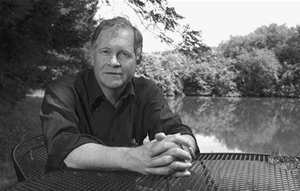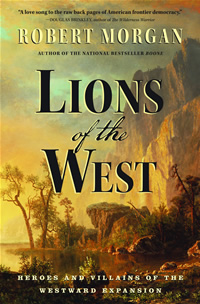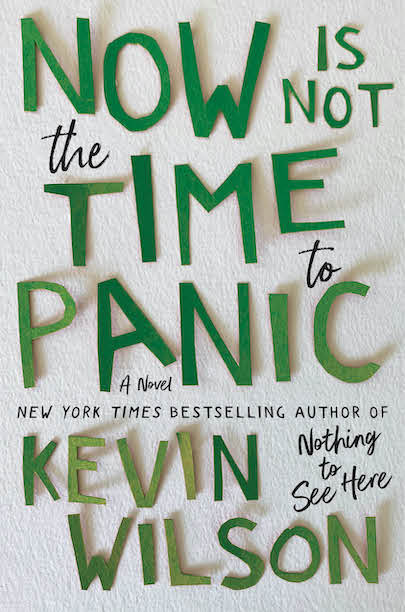Adding On
Robert Morgan retells the history of America’s westward expansion
When most Americans think of the Wild West, images of George Custer, Sitting Bull, Doc Holliday, and other legendary figures of the late-nineteenth century come to mind. As Robert Morgan points out, however, America’s western boundaries were set during the first half of that pivotal century by an entirely different cast of characters. In Lions of the West: Heroes and Villains of the Westward Expansion, Morgan writes about the men who added the territories from the Appalachians to the Pacific, thereby making a country out of a continent.
Lions of the West is a compendium of short biographies of the key figures—ten in all—from America’s great age of expansion. Each of them contributed more than his fair share to a policy of Manifest Destiny that would come to be viewed as either the best or worst thing America ever did. Some of the names are familiar, including presidents (Jefferson, Jackson, Polk, and John Quincy Adams) and world-famous adventurers (David Crockett and Sam Houston). Others are less well known, including John Chapman—a.k.a. Johnny Appleseed—and Nicholas Trist. Trist, a name almost certainly unknown to most contemporary Americans, was a confidante of Jefferson and Jackson and the negotiator of the treaty that ended the Mexican War, acquiring virtually the entire region that is now the Southwestern United States.
 Morgan, award-winning author of the novel Gap Creek, a biography of frontiersman Daniel Boone, and other works, begins Lions of the West with Jefferson, who by negotiating the purchase of the Louisiana Territory pulled off one of the greatest land deals of all time. Jefferson was famously curious about everything, a bibliophile and polymath who believed that America was and forever should be a nation of farmers unshackled from a strong central government. He was so enthralled with the American West and what it might mean to the nation that he built Monticello on a hill, “where he could see farthest, to the distant chain of mountains, to the future, and the Far West where that future would be realized.”
Morgan, award-winning author of the novel Gap Creek, a biography of frontiersman Daniel Boone, and other works, begins Lions of the West with Jefferson, who by negotiating the purchase of the Louisiana Territory pulled off one of the greatest land deals of all time. Jefferson was famously curious about everything, a bibliophile and polymath who believed that America was and forever should be a nation of farmers unshackled from a strong central government. He was so enthralled with the American West and what it might mean to the nation that he built Monticello on a hill, “where he could see farthest, to the distant chain of mountains, to the future, and the Far West where that future would be realized.”
That far horizon was, of course, already occupied by the Native Americans. An undercurrent throughout Morgan’s narrative is the constantly shifting alliances and conflicts between and among the various tribes and factions of both Indians and whites. One of the revelations of this book is that fear of war with Britain or Spain is what actually motivated at least some of America’s duplicitous dealings with its Indian neighbors. This aspect of westward expansion, though too complex for full explication in Morgan’s summary biographies, accounts for much of the villainy mentioned in the book’s subtitle.
 For an example of heroism, Morgan turns to one of the lesser known but most colorful of his subjects, Johnny Appleseed. The westward expansion he chronicles was really more of a grass-roots movement than a fully developed government policy. Regardless of what the politicians may have wanted, settlers moved west to accommodate their desire for freedom and to escape crowding in the east. John Chapman was one of those common people, albeit one with an uncommon way. In planting orchards throughout Ohio and into bordering states, he literally sowed the seeds of civilization. “Americans,” Morgan notes, “have been described as either bullies or saints, and John Chapman inspired a sense of saintliness in the developing culture.”
For an example of heroism, Morgan turns to one of the lesser known but most colorful of his subjects, Johnny Appleseed. The westward expansion he chronicles was really more of a grass-roots movement than a fully developed government policy. Regardless of what the politicians may have wanted, settlers moved west to accommodate their desire for freedom and to escape crowding in the east. John Chapman was one of those common people, albeit one with an uncommon way. In planting orchards throughout Ohio and into bordering states, he literally sowed the seeds of civilization. “Americans,” Morgan notes, “have been described as either bullies or saints, and John Chapman inspired a sense of saintliness in the developing culture.”
Morgan’s account of expansion relies heavily on the stories of intrigue and the daring of men who fought and won America’s first elective war, the 1840s conflict with Mexico. President Polk, known as Young Hickory because his mentor was fellow Tennessean Andrew Jackson, viewed expansion as necessary to maintain the agrarian nature of the U.S. On the death of Jackson, Polk realized “that it was now up to him to carry the republic forward to the West,” writes Morgan. Texas had already rebelled against a corrupt and ineffective regime in Mexico City, and Polk had no trouble instigating conflict about the ownership of California, too, even over the objections of such politicians as John Quincy Adams and Abraham Lincoln. And as long as Texas and California were being annexed, why not the future states of New Mexico and Arizona as well? With Trist’s negotiating skills at his disposal, Polk won it all, getting the credit—or blame—for deciding America’s continental destiny.
As in all honest histories, Lions of the West reveals why the terms hero and villain are often interchangeable, shifting with not only an observer’s own political point of view but also the particular period of the subject’s life. Motives can be complicated things, and the national expansion was, like all historical events, driven by that notoriously complex lot called human beings. Morgan does a good job of investigating these people, trying to understand why they did what they did. But whatever their motives, by the early 1850s they had set the borders of the contiguous United States. The stories of what America did with all that land are fodder for other books.
On November 14 at 7 p.m., Robert Morgan will read from Lions of the West: Heroes and Villains of the Westward Expansion at the Hodges Library on the University of Tennessee campus in Knoxville.


